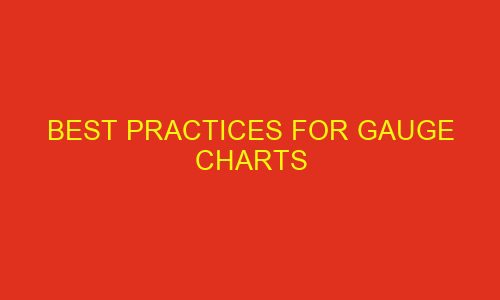Gauge charts are a great way to display data, but there are a few things to keep in mind to make sure they’re effective. Keep reading for the best practices for gauge charts.What are the most common types of gauge charts?
The most common type of gauge chart is the speedometer gauge, which measures how fast a car is going. Other types of gauge charts include the thermometer gauge, which measures temperature, and the barometer gauge, which measures air pressure.
Gauge charts are used to display data that can be measured on a continuum. The data is plotted on a scale, with the X-axis representing the measurement and the Y-axis representing the value. Gauge charts are often used to display data that is changing over time, such as the speed of a car or the temperature of the air.
How do you create a gauge chart?
Gauge charts, also known as speedometers or dials, are used to indicate the current state of a process or system. They can be used to show data over time, data comparisons, or target values. When creating gauge charts, there are some best practices to follow that will ensure your chart is effective and easy to read.
The first thing you want to do when creating a gauge chart with a program like Excel is determine the range of values you will be displaying. This will help you determine the size and scale of your chart. You will also need to decide on a unit of measurement for your data. Common units include percentage, time (in seconds), monetary value (dollars), and others.
Once you have determined the range of values and unit of measurement, you can start plotting your data points. Begin by plotting the starting point on the left side of the chart and then plot each subsequent point on the right side. Be sure to connect each point with a line so that it forms a complete circle. You may also want to add labels indicating what each value represents.
Finally, once your chart is complete, make sure to test it out on different devices and screen sizes to ensure that it is readable in all formats.
Use gauge charts to show progress towards a goal.
Gauge charts are a visual way to track progress towards a goal. They can be used to show how close you are to meeting a goal, or how much progress you have made. The best way to use gauge charts is to set up your goals in advance and create the gauge chart accordingly. This will help ensure that the chart is an accurate representation of your progress.
Make sure the scale of the gauge chart is appropriate for the data it displays.
When creating a gauge chart, it is important to make sure the scale of the gauge is appropriate for the data it displays. If the scale is too small, the data will be difficult to see; if the scale is too large, the data will be compressed and difficult to interpret. It is also important to choose an appropriate unit of measurement for the gauge. For example, if you are measuring temperature, you would want to use degrees Celsius or Fahrenheit rather than inches or centimeters.
Label gauges clearly so that users know what they’re looking at.
Labeling gauges clearly will help people understand the data being represented and make better decisions. In addition, use consistent formatting across all gauges to maintain a cohesive look in your dashboard or report. For example, use the same font size, color, and alignment for all labels.
Keep the formatting of gauge charts simple and uncluttered.
The best way to keep gauge charts simple and uncluttered is to use a limited number of formatting options. This will help ensure that the focus remains on the data, rather than on the chart itself. In addition, it is important to choose an appropriate scale for the gauge and to use consistent units of measurement. By following these tips, you can create clear and informative gauge charts that are easy to understand.
Overall, gauge charts are important because they can help to ensure that your data is accurately represented and that your audience can understand your message. By following the best practices, you can create charts that are effective and visually appealing.

